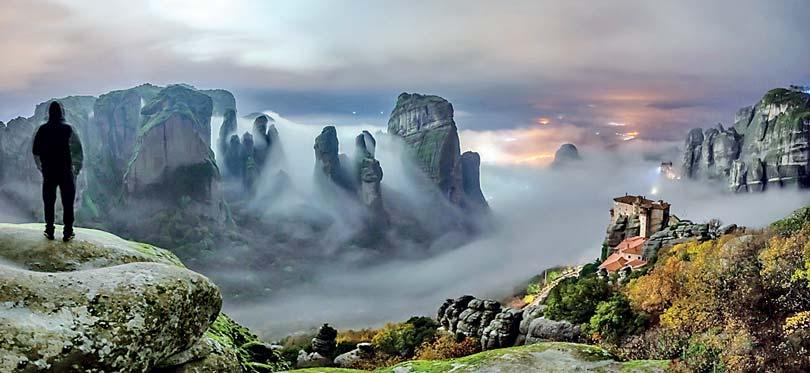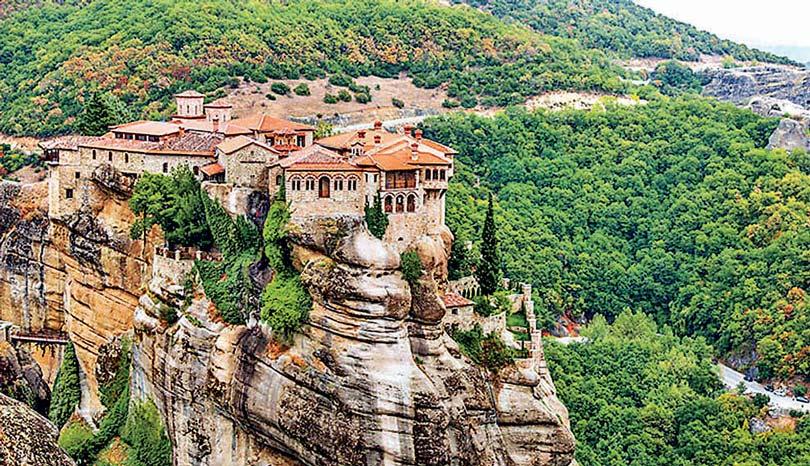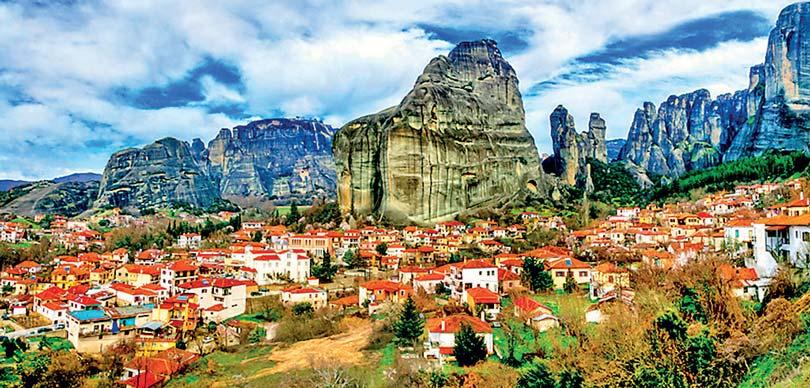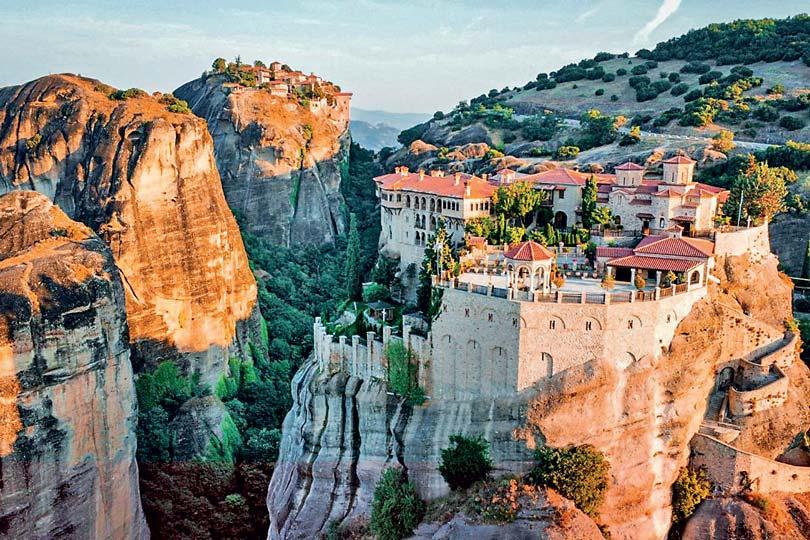




Before the monasteries came the rocks. The towering stone spires of Meteora began forming over 60 million years ago, during the Paleogene period, when the region was still under a prehistoric sea.
Meteora’s true magic lies in what sits atop these stone towers. Between the 14th and 16th centuries, Orthodox monks seeking solitude and divine closeness fled persecution and worldly distractions by ascending to the tops of these inaccessible cliffs.

High above the plains of Thessaly in central Greece, beyond winding roads and sleepy villages, an ethereal sight emerges a cluster of colossal sandstone pillars stretching toward the heavens. Perched precariously on their peaks are centuries-old monasteries, seemingly suspended between earth and sky. This is Meteora, one of the world’s most otherworldly, awe-inspiring destinations.
With a name that means “suspended in air,” Meteora is more than just a UNESCO World Heritage Site; it is a place where geology, history, spirituality, and natural beauty converge to create an unforgettable experience.
Before the monasteries came the rocks. The towering stone spires of Meteora began forming over 60 million years ago, during the Paleogene period, when the region was still under a prehistoric sea. Earthquakes, wind, and water erosion over millennia chiseled these rocks into the dramatic pillars that rise as high as 400 meters today.
From afar, the pillars look like the fingers of the earth trying to grasp the sky. Some are smooth and dome-like, while others are jagged and sheer, with vertical cliffs that seem impossible to scale. Standing beneath them, one feels both insignificant and enchanted.
Meteora’s true magic lies in what sits atop these stone towers. Between the 14th and 16th centuries, Orthodox monks seeking solitude and divine closeness fled persecution and worldly distractions by ascending to the tops of these inaccessible cliffs. Using ropes, nets, and wooden ladders, they carried stones, food, and even people to build what would become one of Christianity’s most remarkable monastic communities.
At its peak, Meteora was home to 24 monasteries, each perched on a different rock summit. Today, six remain active, serving as both places of worship and as living museums of Orthodox Christian heritage. These monasteries blend so harmoniously with the rock that they appear to have grown out of it.
Visiting Meteora is like stepping into a time capsule of religious devotion and architectural brilliance. Each of the six remaining monasteries; Great Meteoron, Varlaam, Roussanou, St. Stephen’s, Holy Trinity, and St. Nicholas Anapausas has its own charm.
The Great Meteoron Monastery, the largest and oldest, offers a rich glimpse into monastic life with its frescoed chapels, ancient manuscripts, and rustic kitchen.
Varlaam Monastery, accessible by a bridge, impresses visitors with its striking position and ornate interior.
- Roussanou Monastery, run by nuns, is the most photogenic and inviting, nestled on a lower rock with flower-filled balconies.
- St. Stephen’s Monastery, also operated by nuns, offers panoramic views of the valley and an easy-to-reach location.
- Holy Trinity Monastery, famously featured in the James Bond film For Your Eyes Only, is the most secluded and challenging to reach, rewarding those who climb its steep steps with silence and serenity.
- St. Nicholas Anapausas, the smallest, is filled with remarkable 16th-century frescoes painted by the renowned Cretan artist Theophanes.
While Meteora is deeply rooted in Greek Orthodox Christianity, its appeal is universal. Visitors of all backgrounds come not only for the religious heritage but also for the spiritual energy that seems to pulse through the rocks.
Many describe a profound sense of peace upon arrival a stillness that contrasts sharply with the fast-paced noise of the modern world. Whether you’re walking a forested trail between monasteries or sitting quietly on a rocky outcrop as the sun sets behind the peaks, Meteora has a way of quieting the mind and stirring the soul.
Meteora isn’t just for monks and history buffs. It’s also a paradise for nature lovers and adventurers. A network of ancient footpaths and hiking trails winds through the area, offering spectacular views, caves, hidden chapels, and even glimpses of the old scaffolding used by the monks.
Some of the best hikes include:
- The trail from Kastraki village to the Holy Trinity Monastery, which combines nature, history, and heart-pumping climbs.
- The Path of the Monks, connecting the Great Meteoron and Varlaam monasteries, with breathtaking overlooks.
- Sunset Rock, a less-traveled spot where golden hour paints the pillars in warm hues.
These trails are ideal in spring and fall, when wildflowers bloom or autumn leaves fall gently over ancient stone paths.
For photographers, Meteora is a dreamscape. The changing light throughout the day transforms the rocks and monasteries into living sculptures. At dawn, morning mist weaves between the pillars. By afternoon, sunbeams highlight the stone textures and red-tiled roofs. Come sunset, the entire landscape glows with surreal golden light. Drone photography, though restricted in some areas for preservation, has also revealed the full scale of this natural and man-made masterpiece but nothing compares to seeing it with your own eyes.
A Taste of Local Life
Beyond the mysticism and stone, Meteora is also home to warm hospitality, delicious food, and rich Greek culture. The villages of Kalambaka and Kastraki, nestled at the foot of the rocks, offer cozy tavernas serving hearty dishes like moussaka, souvlaki, fresh feta, and Meteora’s own wine. Local guesthouses often provide balconies with astonishing views, and locals are always eager to share stories or point you to a hidden trail or chapel.
Preserving the Floating Monasteries
Today, Meteora faces the dual challenge of maintaining its sanctity while accommodating a growing number of tourists. Conservation efforts are underway to protect the fragile stone, ancient frescoes, and the quiet environment. Visitors are encouraged to dress modestly, speak respectfully, and tread lightly. The monks and nuns continue to live, pray, and work in these sky-high retreats, offering a glimpse of a life devoted to simplicity and spirit in a chaotic world.
Why You Should Visit Meteora
In a world full of overstimulating attractions and Instagram traps, Meteora offers something different: stillness, wonder, and meaning. It’s a reminder of what happens when humans don’t try to conquer nature but work in harmony with it. Whether you seek adventure, history, spiritual insight, or just a moment of quiet in a noisy world, Meteora will give you something that lingers long after you leave.
Not just photographs or facts, but a feeling.
A memory of stone and sky, and a deep breath of peace.











